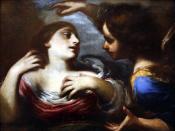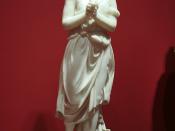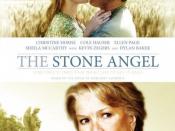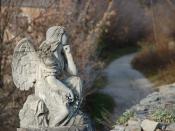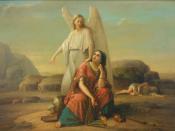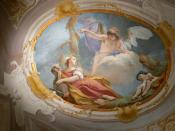Stone Angel The literary purpose of the beginning part of Stone Angel is to provide expository information on the main characters, the setting, and the situation through the use of symbolism. The author has, without actually describing the main character, know her background family life, her childhood home, her thoughts, and parts of her personality. It is set up in such a way to allow the reader interest into the rest of the story, as well, as guess at what is to come. The symbols of the stone angel, the cemetery it is in, and the flowers found within allow us to glimpse into the main characters head before she is formally heard or discussed.
The first thing that we are able to learn about is the main characters mother and father. We learn that her mother died giving birth to her, as she áçrelinquished her feeble ghost as I gained my stubborn one.áè
We learn that her father bought the memorial of the stone angel not out of love or remembrance to this woman, but rather to áçproclaim his dynastyáè forever, to be forever telling the town that he was wealthy enough to provide such a burial for his wife, that he was good enough. The stone angel stood not as a tribute, but rather as a means for self-advancement in the eyes of the town. The angel itself serves as a symbol perhaps of the woman she was bought to remember, the main characters mother. She has áçsightless eyes,áè and was áçdoubly blind, not only stone but unendowed without even a pretense of sight.áè This appears to be a symbol tribute to the mother, someone who was never truly able to see the world around her, never able to view with unbiased eyes, her own husband. The angel was áçbrought from Italy at a terrible expense and was pure white marble . . . She must have been carved in the distant sun by stone masons . . . gouging her like out by the score . . . gauging with admirable accuracy . . . of fledgling pharaohs in an uncouth land.áè This shows us perhaps what the father actually thought of the woman who was her wife, and seems to be a symbol of such. She seems to be more of an ornament to him, someone who will look good on his arm, rather then someone who he lives without out of love for her person. Just as those who cared not at all about her carved the stone angel in a distant place, so does this woman seem to have existed with a man who seems not to have cared much about her. Through this description of the stone angel, we are able to see what the main character parents were like, and though she never knew her mother, this has obviously had a large effect on her. We glimpse into her fatheráæs personality, a semi-cold man who uses even his wifeáæs death for personal advancement and pride.
The second thing we learn of is the setting of this novel, which ends up being the childhood setting of the main character. We learn that there are distinct seasons, the angels áçwings in winter were pitted by the snow, and in the summer by the brown grit.áè We know they lived in a small town, Manawaka, and that this was a long time ago. áçShe was the first, the largest and certainly the costliest.áè This again tells us not only about the setting, that it was a long time ago in the past, but also again brings up the circumstances she was bought under. We learn enough in this paragraph to learn where at least part of the story will take place.
We then begin learning about the personality of our main character, Hagar. Hagar speaks of the woman Regina, who was áçnow forgotten in Manawaka.áè However Hagar compares this womanáæs fate to her own áç . . . I, Hagar, am doubtless forgotten.áè We are able to see that a long time has passed since 1886 when Regina died, and also that Hagar has moved away from this town, and not left anyone really there (such as relations) who would truly remember her. Hagar tells us that she áçalways felt she [Regina] had only herself to blame, for she was a flimsy, gutless creature, bland as egg custard . . .áè However, Hagar never again compares this description to herself, providing our first insight into her character, that she does not truly see who she is, that she believes she is above others. While she is able to say that she is forgotten like Regina, she never makes that comparison that she only has herself to blame, and the reasoning for this. Hagar then provides a brief narrative into her childhood life. She tells us that she used to walk in the cemetery as a child, but that there were áçnot have been many places to walk primly in those days . . . where white kid boots and dangling skirts would not be torn by thistles or put in unseemly disarray.áè This description leads us to believe that she had a very prim and proper upbringing from her father, and even as a child was a very prim person, seemingly reserved. Her next description proves this point. áçHow anxious I was to be neat and orderly, imagining life had been created only to celebrate tidiness . . .áè She was obviously brought up quite stiffly in a way that would not allow her to behave as most children do. Through her own narrative, we are able to create a basic picture of Hagar.
The final things we learn about utilize the symbol of flowers to foreshadow into the book and Hagaráæs life. áçIn summer the cemetery was rich and thick as syrup with the funeral-parlor perfume of the planted peonies . . .áè This seems to be a metaphor telling us that what once appears pleasant, like flowers, is actually the opposite, providing a áçfuneral-parlor perfumeáè which speaks of death. This is the first of many times that death is mentioned in passing through symbolism in this book, and particularly in the first chapter. áç. . . Too heavy for their light stems, bowed down with the weight of themselves and the weight of the rain, infested with the upstart ants that sauntered through the plush petals as though to the manner born.áè This seems to be another symbol of Hagar herself, as though a glimpse into her later life, a time when she will get so bowed down by herself and those around her when she will collapse. It shows us how fragile something we perceive as beautiful, such as a flower, or a life, actually is and how vulnerable it can be. The last part presents us with another symbol of flowers. áçThey were tough-rooted, these wild and gaudy flowers, and although they were held back at the cemeteryáæs edge, torn out by loving relatives determined to keep the plots clear and clearly civilized . . .áè This again appears to be a metaphor for Hagaráæs life, providing foreshadowing into the book. The description seems to fit what we know to be true of Hagaráæs character later, áçtough-rootedáè and áçgaudyáè. We also see that it again discusses her being held back and in fact torn out by áçloving relatives.áè This seems to suggest that her family will play a large part in her demise, and that they will hold her back from what she want to do. The last line of this part speaks of áç. . . faint, musky, dust-tinged smell of things that grew untended and had grown always, before the portly peonies and the angels with rigid wings, when the prairie bluffs were walked through only by Cree with enigmatic faces and greasy hair.áè This presents us with an image of life before the cemetery, before the town, before Hagaráæs life, and her parentáæs lives existed. It is a tribute to life before, and seems almost melancholy with remembrance, back to life in a more pure time. It seems Hagaráæs way of telling us that life before civilization seems to be better.
The opening section of the novel Stone Angel provides us with a large quantity of information about the life of the main character Hagar, her family, and her childhood. Its purpose is to set up the entire book, through symbolism, narrative and description, and it does an extremely good job of this in an interesting fashion. It sets the tone and style for the remainder of the book, and provides us with insight into the novel, and the story that will be told, of Hagar in the present, reminiscing about her life in the past, as she moves through the future as an old woman.
